Effective Leadership in Health
VerifiedAdded on 2023/03/20
|12
|3335
|37
AI Summary
This article discusses the importance of effective leadership in the healthcare sector and its impact on service delivery. It explores the challenges faced by leaders, issues for healthcare teams, and the development of leadership skills.
Contribute Materials
Your contribution can guide someone’s learning journey. Share your
documents today.
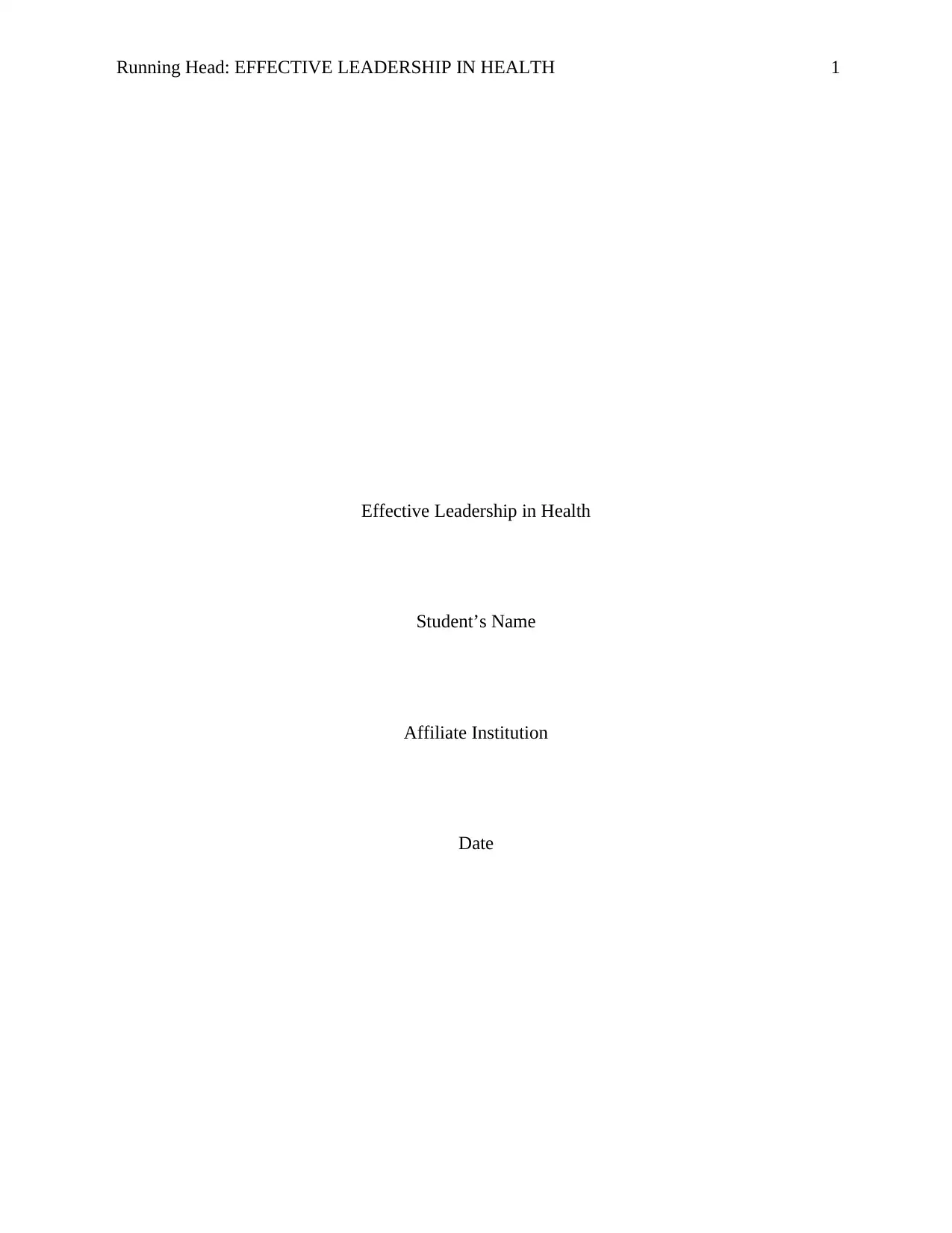
Running Head: EFFECTIVE LEADERSHIP IN HEALTH 1
Effective Leadership in Health
Student’s Name
Affiliate Institution
Date
Effective Leadership in Health
Student’s Name
Affiliate Institution
Date
Secure Best Marks with AI Grader
Need help grading? Try our AI Grader for instant feedback on your assignments.
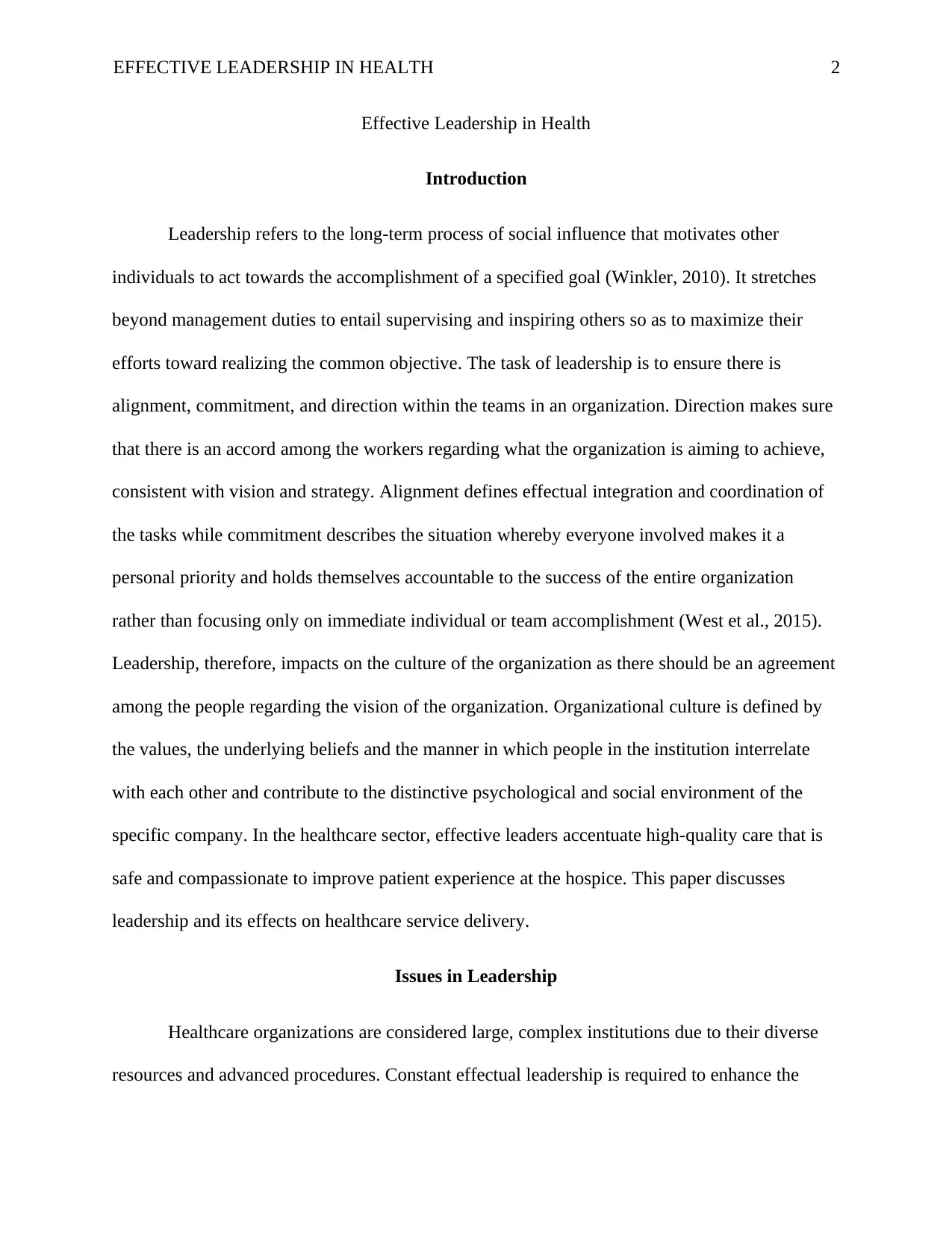
EFFECTIVE LEADERSHIP IN HEALTH 2
Effective Leadership in Health
Introduction
Leadership refers to the long-term process of social influence that motivates other
individuals to act towards the accomplishment of a specified goal (Winkler, 2010). It stretches
beyond management duties to entail supervising and inspiring others so as to maximize their
efforts toward realizing the common objective. The task of leadership is to ensure there is
alignment, commitment, and direction within the teams in an organization. Direction makes sure
that there is an accord among the workers regarding what the organization is aiming to achieve,
consistent with vision and strategy. Alignment defines effectual integration and coordination of
the tasks while commitment describes the situation whereby everyone involved makes it a
personal priority and holds themselves accountable to the success of the entire organization
rather than focusing only on immediate individual or team accomplishment (West et al., 2015).
Leadership, therefore, impacts on the culture of the organization as there should be an agreement
among the people regarding the vision of the organization. Organizational culture is defined by
the values, the underlying beliefs and the manner in which people in the institution interrelate
with each other and contribute to the distinctive psychological and social environment of the
specific company. In the healthcare sector, effective leaders accentuate high-quality care that is
safe and compassionate to improve patient experience at the hospice. This paper discusses
leadership and its effects on healthcare service delivery.
Issues in Leadership
Healthcare organizations are considered large, complex institutions due to their diverse
resources and advanced procedures. Constant effectual leadership is required to enhance the
Effective Leadership in Health
Introduction
Leadership refers to the long-term process of social influence that motivates other
individuals to act towards the accomplishment of a specified goal (Winkler, 2010). It stretches
beyond management duties to entail supervising and inspiring others so as to maximize their
efforts toward realizing the common objective. The task of leadership is to ensure there is
alignment, commitment, and direction within the teams in an organization. Direction makes sure
that there is an accord among the workers regarding what the organization is aiming to achieve,
consistent with vision and strategy. Alignment defines effectual integration and coordination of
the tasks while commitment describes the situation whereby everyone involved makes it a
personal priority and holds themselves accountable to the success of the entire organization
rather than focusing only on immediate individual or team accomplishment (West et al., 2015).
Leadership, therefore, impacts on the culture of the organization as there should be an agreement
among the people regarding the vision of the organization. Organizational culture is defined by
the values, the underlying beliefs and the manner in which people in the institution interrelate
with each other and contribute to the distinctive psychological and social environment of the
specific company. In the healthcare sector, effective leaders accentuate high-quality care that is
safe and compassionate to improve patient experience at the hospice. This paper discusses
leadership and its effects on healthcare service delivery.
Issues in Leadership
Healthcare organizations are considered large, complex institutions due to their diverse
resources and advanced procedures. Constant effectual leadership is required to enhance the
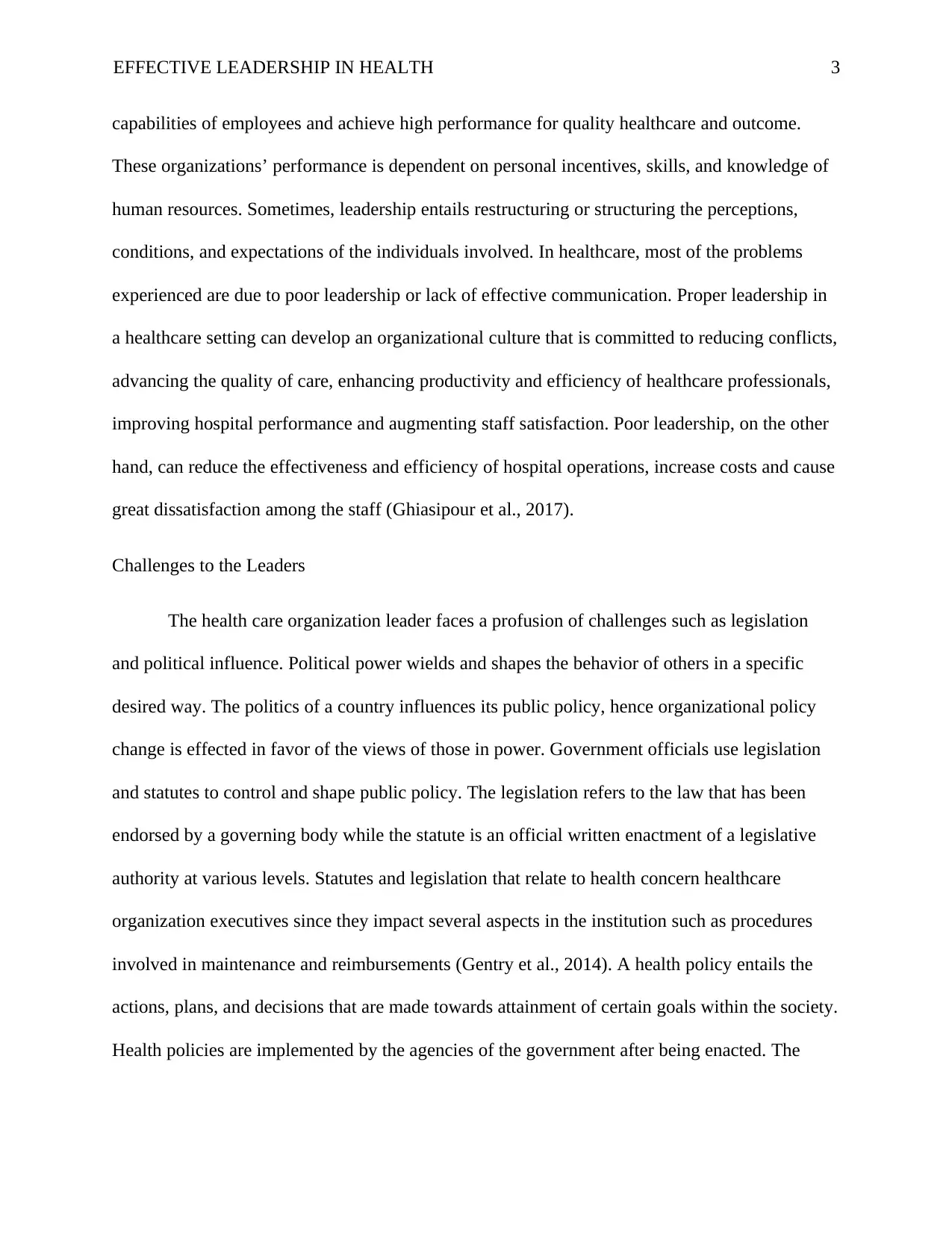
EFFECTIVE LEADERSHIP IN HEALTH 3
capabilities of employees and achieve high performance for quality healthcare and outcome.
These organizations’ performance is dependent on personal incentives, skills, and knowledge of
human resources. Sometimes, leadership entails restructuring or structuring the perceptions,
conditions, and expectations of the individuals involved. In healthcare, most of the problems
experienced are due to poor leadership or lack of effective communication. Proper leadership in
a healthcare setting can develop an organizational culture that is committed to reducing conflicts,
advancing the quality of care, enhancing productivity and efficiency of healthcare professionals,
improving hospital performance and augmenting staff satisfaction. Poor leadership, on the other
hand, can reduce the effectiveness and efficiency of hospital operations, increase costs and cause
great dissatisfaction among the staff (Ghiasipour et al., 2017).
Challenges to the Leaders
The health care organization leader faces a profusion of challenges such as legislation
and political influence. Political power wields and shapes the behavior of others in a specific
desired way. The politics of a country influences its public policy, hence organizational policy
change is effected in favor of the views of those in power. Government officials use legislation
and statutes to control and shape public policy. The legislation refers to the law that has been
endorsed by a governing body while the statute is an official written enactment of a legislative
authority at various levels. Statutes and legislation that relate to health concern healthcare
organization executives since they impact several aspects in the institution such as procedures
involved in maintenance and reimbursements (Gentry et al., 2014). A health policy entails the
actions, plans, and decisions that are made towards attainment of certain goals within the society.
Health policies are implemented by the agencies of the government after being enacted. The
capabilities of employees and achieve high performance for quality healthcare and outcome.
These organizations’ performance is dependent on personal incentives, skills, and knowledge of
human resources. Sometimes, leadership entails restructuring or structuring the perceptions,
conditions, and expectations of the individuals involved. In healthcare, most of the problems
experienced are due to poor leadership or lack of effective communication. Proper leadership in
a healthcare setting can develop an organizational culture that is committed to reducing conflicts,
advancing the quality of care, enhancing productivity and efficiency of healthcare professionals,
improving hospital performance and augmenting staff satisfaction. Poor leadership, on the other
hand, can reduce the effectiveness and efficiency of hospital operations, increase costs and cause
great dissatisfaction among the staff (Ghiasipour et al., 2017).
Challenges to the Leaders
The health care organization leader faces a profusion of challenges such as legislation
and political influence. Political power wields and shapes the behavior of others in a specific
desired way. The politics of a country influences its public policy, hence organizational policy
change is effected in favor of the views of those in power. Government officials use legislation
and statutes to control and shape public policy. The legislation refers to the law that has been
endorsed by a governing body while the statute is an official written enactment of a legislative
authority at various levels. Statutes and legislation that relate to health concern healthcare
organization executives since they impact several aspects in the institution such as procedures
involved in maintenance and reimbursements (Gentry et al., 2014). A health policy entails the
actions, plans, and decisions that are made towards attainment of certain goals within the society.
Health policies are implemented by the agencies of the government after being enacted. The
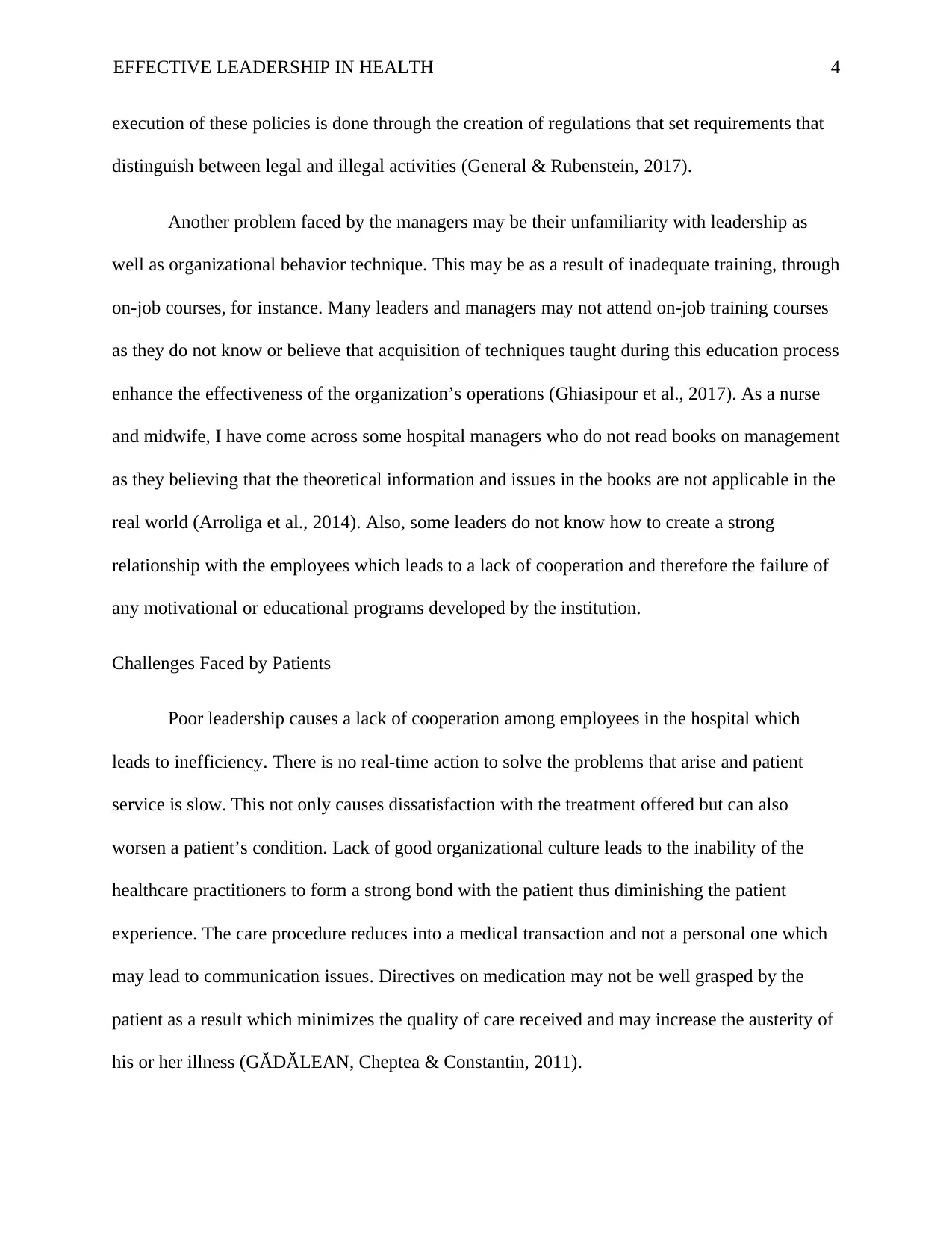
EFFECTIVE LEADERSHIP IN HEALTH 4
execution of these policies is done through the creation of regulations that set requirements that
distinguish between legal and illegal activities (General & Rubenstein, 2017).
Another problem faced by the managers may be their unfamiliarity with leadership as
well as organizational behavior technique. This may be as a result of inadequate training, through
on-job courses, for instance. Many leaders and managers may not attend on-job training courses
as they do not know or believe that acquisition of techniques taught during this education process
enhance the effectiveness of the organization’s operations (Ghiasipour et al., 2017). As a nurse
and midwife, I have come across some hospital managers who do not read books on management
as they believing that the theoretical information and issues in the books are not applicable in the
real world (Arroliga et al., 2014). Also, some leaders do not know how to create a strong
relationship with the employees which leads to a lack of cooperation and therefore the failure of
any motivational or educational programs developed by the institution.
Challenges Faced by Patients
Poor leadership causes a lack of cooperation among employees in the hospital which
leads to inefficiency. There is no real-time action to solve the problems that arise and patient
service is slow. This not only causes dissatisfaction with the treatment offered but can also
worsen a patient’s condition. Lack of good organizational culture leads to the inability of the
healthcare practitioners to form a strong bond with the patient thus diminishing the patient
experience. The care procedure reduces into a medical transaction and not a personal one which
may lead to communication issues. Directives on medication may not be well grasped by the
patient as a result which minimizes the quality of care received and may increase the austerity of
his or her illness (GĂDĂLEAN, Cheptea & Constantin, 2011).
execution of these policies is done through the creation of regulations that set requirements that
distinguish between legal and illegal activities (General & Rubenstein, 2017).
Another problem faced by the managers may be their unfamiliarity with leadership as
well as organizational behavior technique. This may be as a result of inadequate training, through
on-job courses, for instance. Many leaders and managers may not attend on-job training courses
as they do not know or believe that acquisition of techniques taught during this education process
enhance the effectiveness of the organization’s operations (Ghiasipour et al., 2017). As a nurse
and midwife, I have come across some hospital managers who do not read books on management
as they believing that the theoretical information and issues in the books are not applicable in the
real world (Arroliga et al., 2014). Also, some leaders do not know how to create a strong
relationship with the employees which leads to a lack of cooperation and therefore the failure of
any motivational or educational programs developed by the institution.
Challenges Faced by Patients
Poor leadership causes a lack of cooperation among employees in the hospital which
leads to inefficiency. There is no real-time action to solve the problems that arise and patient
service is slow. This not only causes dissatisfaction with the treatment offered but can also
worsen a patient’s condition. Lack of good organizational culture leads to the inability of the
healthcare practitioners to form a strong bond with the patient thus diminishing the patient
experience. The care procedure reduces into a medical transaction and not a personal one which
may lead to communication issues. Directives on medication may not be well grasped by the
patient as a result which minimizes the quality of care received and may increase the austerity of
his or her illness (GĂDĂLEAN, Cheptea & Constantin, 2011).
Secure Best Marks with AI Grader
Need help grading? Try our AI Grader for instant feedback on your assignments.
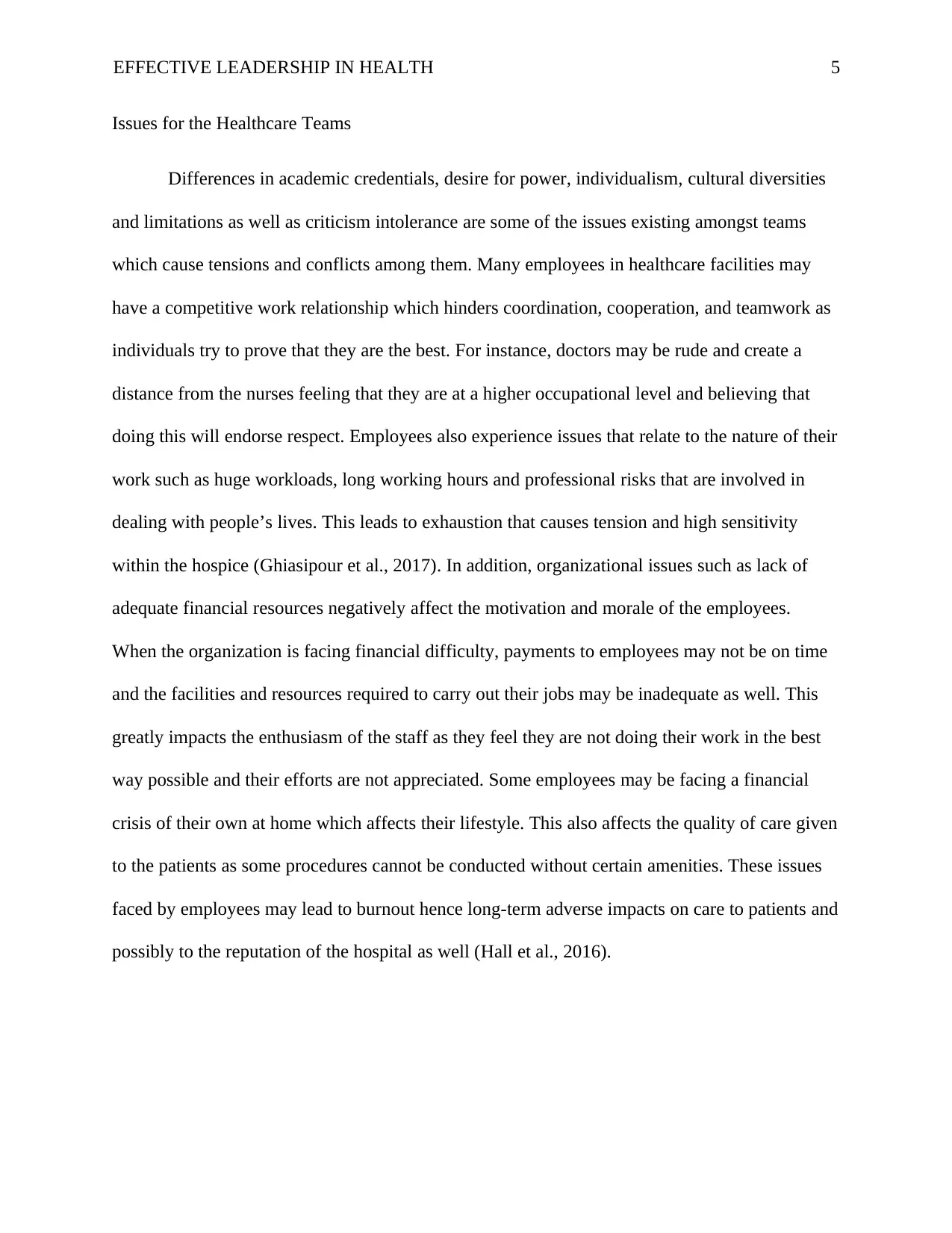
EFFECTIVE LEADERSHIP IN HEALTH 5
Issues for the Healthcare Teams
Differences in academic credentials, desire for power, individualism, cultural diversities
and limitations as well as criticism intolerance are some of the issues existing amongst teams
which cause tensions and conflicts among them. Many employees in healthcare facilities may
have a competitive work relationship which hinders coordination, cooperation, and teamwork as
individuals try to prove that they are the best. For instance, doctors may be rude and create a
distance from the nurses feeling that they are at a higher occupational level and believing that
doing this will endorse respect. Employees also experience issues that relate to the nature of their
work such as huge workloads, long working hours and professional risks that are involved in
dealing with people’s lives. This leads to exhaustion that causes tension and high sensitivity
within the hospice (Ghiasipour et al., 2017). In addition, organizational issues such as lack of
adequate financial resources negatively affect the motivation and morale of the employees.
When the organization is facing financial difficulty, payments to employees may not be on time
and the facilities and resources required to carry out their jobs may be inadequate as well. This
greatly impacts the enthusiasm of the staff as they feel they are not doing their work in the best
way possible and their efforts are not appreciated. Some employees may be facing a financial
crisis of their own at home which affects their lifestyle. This also affects the quality of care given
to the patients as some procedures cannot be conducted without certain amenities. These issues
faced by employees may lead to burnout hence long-term adverse impacts on care to patients and
possibly to the reputation of the hospital as well (Hall et al., 2016).
Issues for the Healthcare Teams
Differences in academic credentials, desire for power, individualism, cultural diversities
and limitations as well as criticism intolerance are some of the issues existing amongst teams
which cause tensions and conflicts among them. Many employees in healthcare facilities may
have a competitive work relationship which hinders coordination, cooperation, and teamwork as
individuals try to prove that they are the best. For instance, doctors may be rude and create a
distance from the nurses feeling that they are at a higher occupational level and believing that
doing this will endorse respect. Employees also experience issues that relate to the nature of their
work such as huge workloads, long working hours and professional risks that are involved in
dealing with people’s lives. This leads to exhaustion that causes tension and high sensitivity
within the hospice (Ghiasipour et al., 2017). In addition, organizational issues such as lack of
adequate financial resources negatively affect the motivation and morale of the employees.
When the organization is facing financial difficulty, payments to employees may not be on time
and the facilities and resources required to carry out their jobs may be inadequate as well. This
greatly impacts the enthusiasm of the staff as they feel they are not doing their work in the best
way possible and their efforts are not appreciated. Some employees may be facing a financial
crisis of their own at home which affects their lifestyle. This also affects the quality of care given
to the patients as some procedures cannot be conducted without certain amenities. These issues
faced by employees may lead to burnout hence long-term adverse impacts on care to patients and
possibly to the reputation of the hospital as well (Hall et al., 2016).
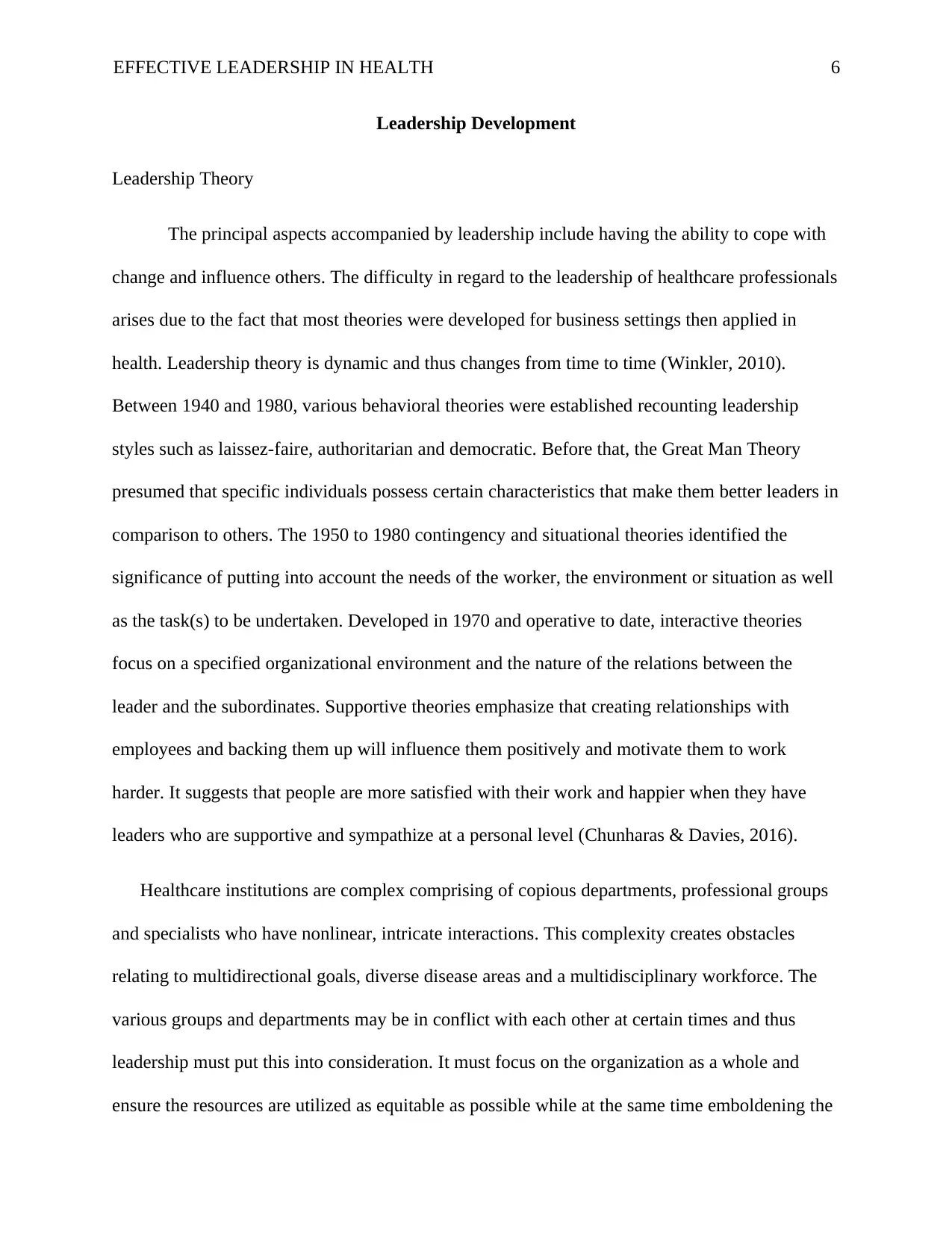
EFFECTIVE LEADERSHIP IN HEALTH 6
Leadership Development
Leadership Theory
The principal aspects accompanied by leadership include having the ability to cope with
change and influence others. The difficulty in regard to the leadership of healthcare professionals
arises due to the fact that most theories were developed for business settings then applied in
health. Leadership theory is dynamic and thus changes from time to time (Winkler, 2010).
Between 1940 and 1980, various behavioral theories were established recounting leadership
styles such as laissez-faire, authoritarian and democratic. Before that, the Great Man Theory
presumed that specific individuals possess certain characteristics that make them better leaders in
comparison to others. The 1950 to 1980 contingency and situational theories identified the
significance of putting into account the needs of the worker, the environment or situation as well
as the task(s) to be undertaken. Developed in 1970 and operative to date, interactive theories
focus on a specified organizational environment and the nature of the relations between the
leader and the subordinates. Supportive theories emphasize that creating relationships with
employees and backing them up will influence them positively and motivate them to work
harder. It suggests that people are more satisfied with their work and happier when they have
leaders who are supportive and sympathize at a personal level (Chunharas & Davies, 2016).
Healthcare institutions are complex comprising of copious departments, professional groups
and specialists who have nonlinear, intricate interactions. This complexity creates obstacles
relating to multidirectional goals, diverse disease areas and a multidisciplinary workforce. The
various groups and departments may be in conflict with each other at certain times and thus
leadership must put this into consideration. It must focus on the organization as a whole and
ensure the resources are utilized as equitable as possible while at the same time emboldening the
Leadership Development
Leadership Theory
The principal aspects accompanied by leadership include having the ability to cope with
change and influence others. The difficulty in regard to the leadership of healthcare professionals
arises due to the fact that most theories were developed for business settings then applied in
health. Leadership theory is dynamic and thus changes from time to time (Winkler, 2010).
Between 1940 and 1980, various behavioral theories were established recounting leadership
styles such as laissez-faire, authoritarian and democratic. Before that, the Great Man Theory
presumed that specific individuals possess certain characteristics that make them better leaders in
comparison to others. The 1950 to 1980 contingency and situational theories identified the
significance of putting into account the needs of the worker, the environment or situation as well
as the task(s) to be undertaken. Developed in 1970 and operative to date, interactive theories
focus on a specified organizational environment and the nature of the relations between the
leader and the subordinates. Supportive theories emphasize that creating relationships with
employees and backing them up will influence them positively and motivate them to work
harder. It suggests that people are more satisfied with their work and happier when they have
leaders who are supportive and sympathize at a personal level (Chunharas & Davies, 2016).
Healthcare institutions are complex comprising of copious departments, professional groups
and specialists who have nonlinear, intricate interactions. This complexity creates obstacles
relating to multidirectional goals, diverse disease areas and a multidisciplinary workforce. The
various groups and departments may be in conflict with each other at certain times and thus
leadership must put this into consideration. It must focus on the organization as a whole and
ensure the resources are utilized as equitable as possible while at the same time emboldening the
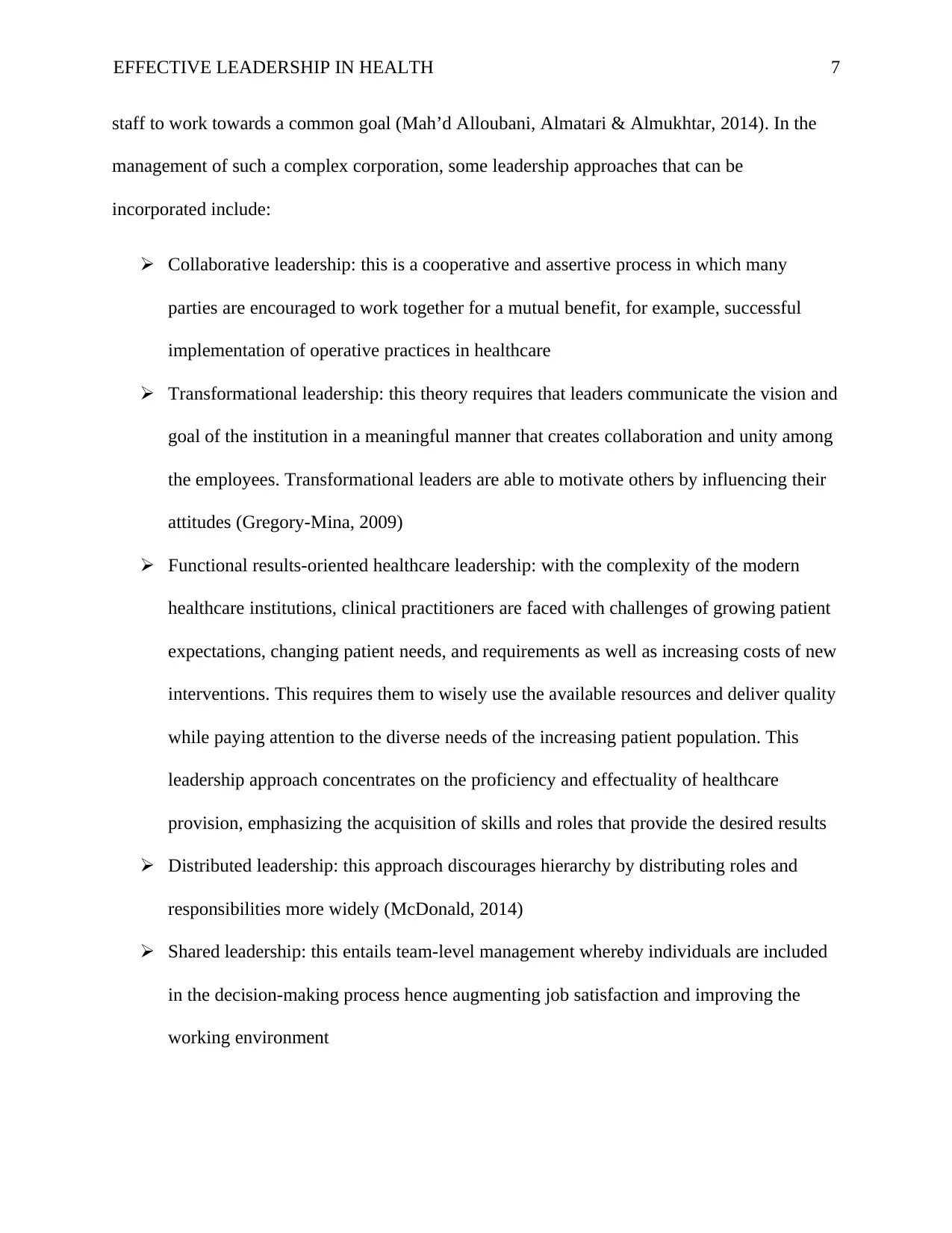
EFFECTIVE LEADERSHIP IN HEALTH 7
staff to work towards a common goal (Mah’d Alloubani, Almatari & Almukhtar, 2014). In the
management of such a complex corporation, some leadership approaches that can be
incorporated include:
Collaborative leadership: this is a cooperative and assertive process in which many
parties are encouraged to work together for a mutual benefit, for example, successful
implementation of operative practices in healthcare
Transformational leadership: this theory requires that leaders communicate the vision and
goal of the institution in a meaningful manner that creates collaboration and unity among
the employees. Transformational leaders are able to motivate others by influencing their
attitudes (Gregory-Mina, 2009)
Functional results-oriented healthcare leadership: with the complexity of the modern
healthcare institutions, clinical practitioners are faced with challenges of growing patient
expectations, changing patient needs, and requirements as well as increasing costs of new
interventions. This requires them to wisely use the available resources and deliver quality
while paying attention to the diverse needs of the increasing patient population. This
leadership approach concentrates on the proficiency and effectuality of healthcare
provision, emphasizing the acquisition of skills and roles that provide the desired results
Distributed leadership: this approach discourages hierarchy by distributing roles and
responsibilities more widely (McDonald, 2014)
Shared leadership: this entails team-level management whereby individuals are included
in the decision-making process hence augmenting job satisfaction and improving the
working environment
staff to work towards a common goal (Mah’d Alloubani, Almatari & Almukhtar, 2014). In the
management of such a complex corporation, some leadership approaches that can be
incorporated include:
Collaborative leadership: this is a cooperative and assertive process in which many
parties are encouraged to work together for a mutual benefit, for example, successful
implementation of operative practices in healthcare
Transformational leadership: this theory requires that leaders communicate the vision and
goal of the institution in a meaningful manner that creates collaboration and unity among
the employees. Transformational leaders are able to motivate others by influencing their
attitudes (Gregory-Mina, 2009)
Functional results-oriented healthcare leadership: with the complexity of the modern
healthcare institutions, clinical practitioners are faced with challenges of growing patient
expectations, changing patient needs, and requirements as well as increasing costs of new
interventions. This requires them to wisely use the available resources and deliver quality
while paying attention to the diverse needs of the increasing patient population. This
leadership approach concentrates on the proficiency and effectuality of healthcare
provision, emphasizing the acquisition of skills and roles that provide the desired results
Distributed leadership: this approach discourages hierarchy by distributing roles and
responsibilities more widely (McDonald, 2014)
Shared leadership: this entails team-level management whereby individuals are included
in the decision-making process hence augmenting job satisfaction and improving the
working environment
Paraphrase This Document
Need a fresh take? Get an instant paraphrase of this document with our AI Paraphraser
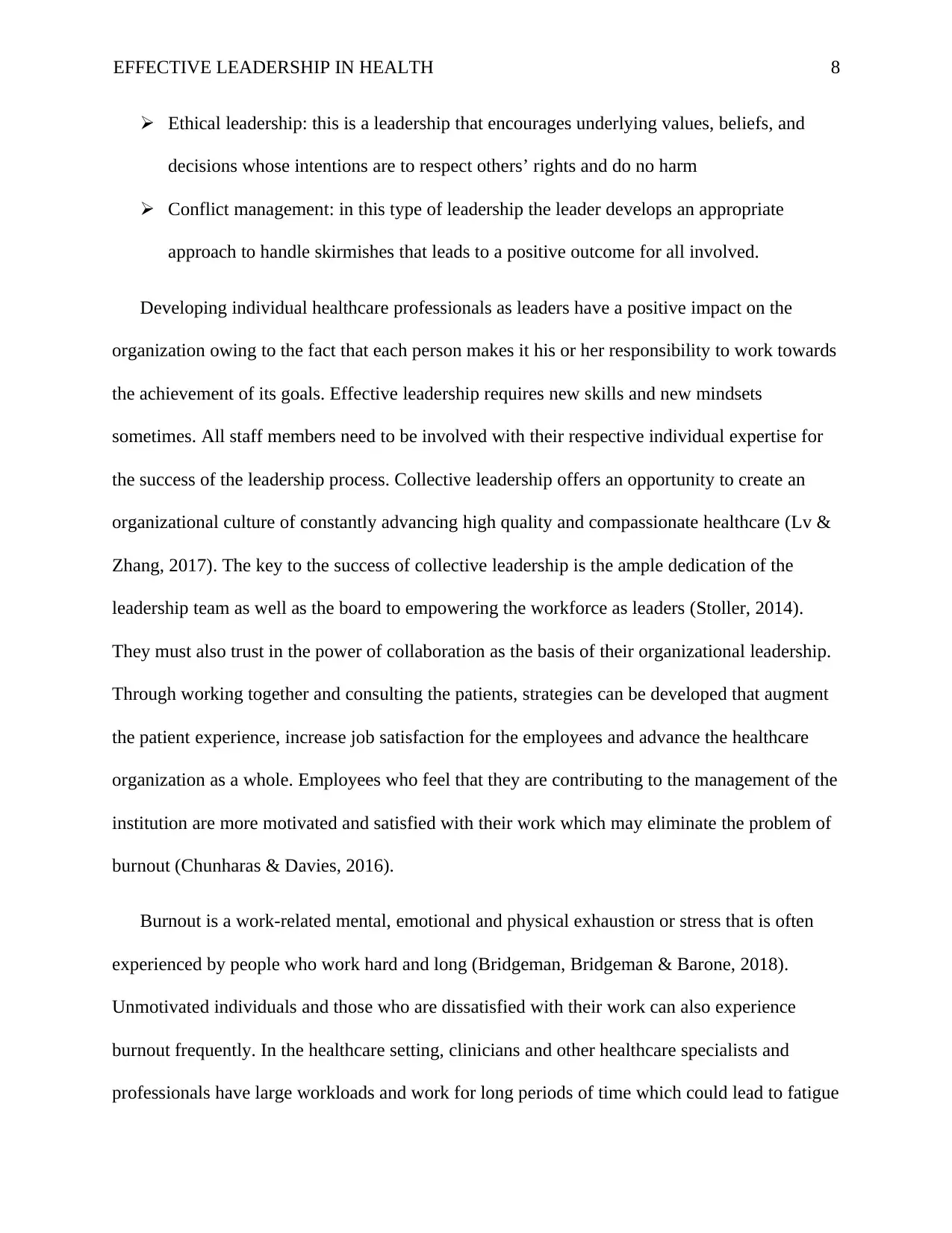
EFFECTIVE LEADERSHIP IN HEALTH 8
Ethical leadership: this is a leadership that encourages underlying values, beliefs, and
decisions whose intentions are to respect others’ rights and do no harm
Conflict management: in this type of leadership the leader develops an appropriate
approach to handle skirmishes that leads to a positive outcome for all involved.
Developing individual healthcare professionals as leaders have a positive impact on the
organization owing to the fact that each person makes it his or her responsibility to work towards
the achievement of its goals. Effective leadership requires new skills and new mindsets
sometimes. All staff members need to be involved with their respective individual expertise for
the success of the leadership process. Collective leadership offers an opportunity to create an
organizational culture of constantly advancing high quality and compassionate healthcare (Lv &
Zhang, 2017). The key to the success of collective leadership is the ample dedication of the
leadership team as well as the board to empowering the workforce as leaders (Stoller, 2014).
They must also trust in the power of collaboration as the basis of their organizational leadership.
Through working together and consulting the patients, strategies can be developed that augment
the patient experience, increase job satisfaction for the employees and advance the healthcare
organization as a whole. Employees who feel that they are contributing to the management of the
institution are more motivated and satisfied with their work which may eliminate the problem of
burnout (Chunharas & Davies, 2016).
Burnout is a work-related mental, emotional and physical exhaustion or stress that is often
experienced by people who work hard and long (Bridgeman, Bridgeman & Barone, 2018).
Unmotivated individuals and those who are dissatisfied with their work can also experience
burnout frequently. In the healthcare setting, clinicians and other healthcare specialists and
professionals have large workloads and work for long periods of time which could lead to fatigue
Ethical leadership: this is a leadership that encourages underlying values, beliefs, and
decisions whose intentions are to respect others’ rights and do no harm
Conflict management: in this type of leadership the leader develops an appropriate
approach to handle skirmishes that leads to a positive outcome for all involved.
Developing individual healthcare professionals as leaders have a positive impact on the
organization owing to the fact that each person makes it his or her responsibility to work towards
the achievement of its goals. Effective leadership requires new skills and new mindsets
sometimes. All staff members need to be involved with their respective individual expertise for
the success of the leadership process. Collective leadership offers an opportunity to create an
organizational culture of constantly advancing high quality and compassionate healthcare (Lv &
Zhang, 2017). The key to the success of collective leadership is the ample dedication of the
leadership team as well as the board to empowering the workforce as leaders (Stoller, 2014).
They must also trust in the power of collaboration as the basis of their organizational leadership.
Through working together and consulting the patients, strategies can be developed that augment
the patient experience, increase job satisfaction for the employees and advance the healthcare
organization as a whole. Employees who feel that they are contributing to the management of the
institution are more motivated and satisfied with their work which may eliminate the problem of
burnout (Chunharas & Davies, 2016).
Burnout is a work-related mental, emotional and physical exhaustion or stress that is often
experienced by people who work hard and long (Bridgeman, Bridgeman & Barone, 2018).
Unmotivated individuals and those who are dissatisfied with their work can also experience
burnout frequently. In the healthcare setting, clinicians and other healthcare specialists and
professionals have large workloads and work for long periods of time which could lead to fatigue
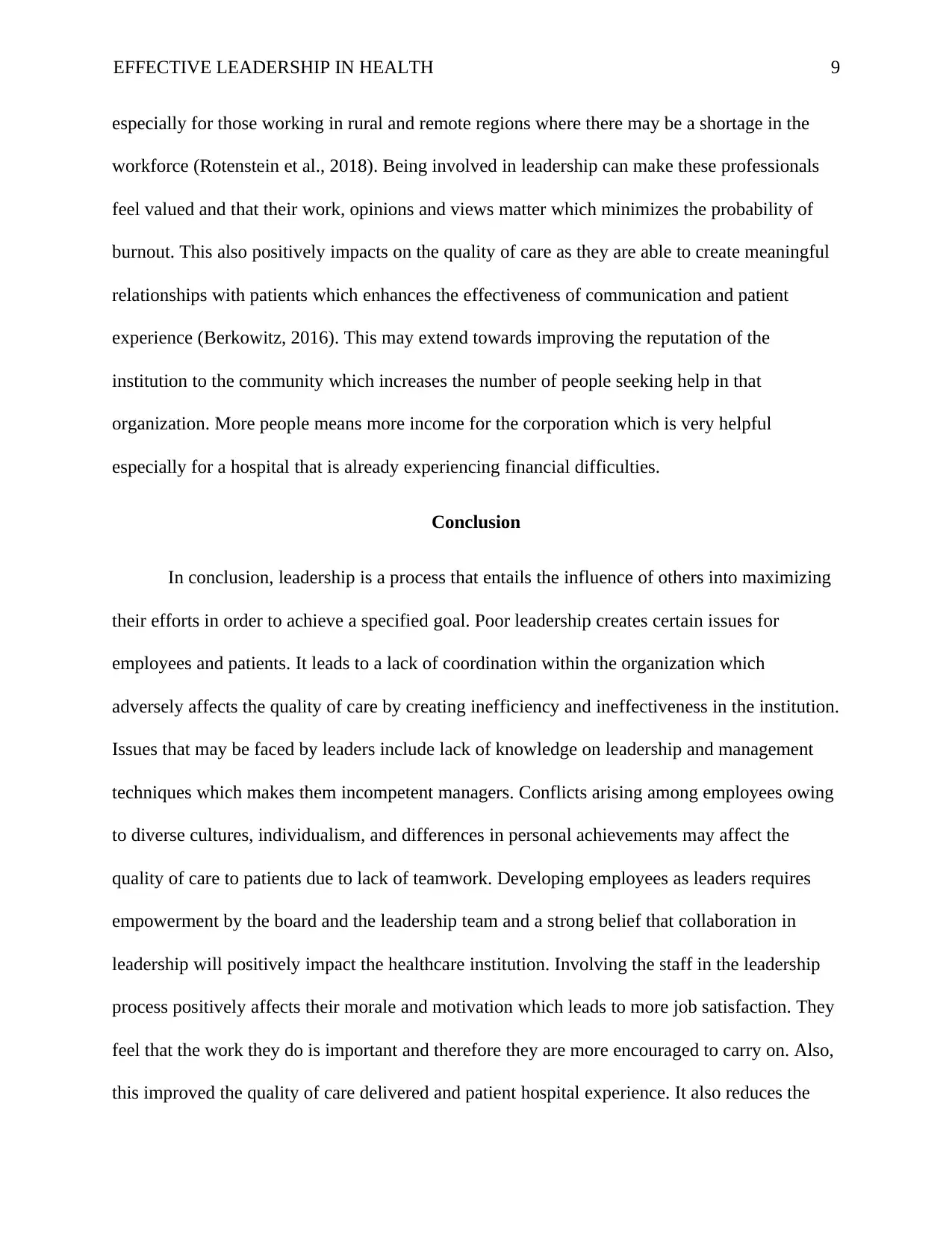
EFFECTIVE LEADERSHIP IN HEALTH 9
especially for those working in rural and remote regions where there may be a shortage in the
workforce (Rotenstein et al., 2018). Being involved in leadership can make these professionals
feel valued and that their work, opinions and views matter which minimizes the probability of
burnout. This also positively impacts on the quality of care as they are able to create meaningful
relationships with patients which enhances the effectiveness of communication and patient
experience (Berkowitz, 2016). This may extend towards improving the reputation of the
institution to the community which increases the number of people seeking help in that
organization. More people means more income for the corporation which is very helpful
especially for a hospital that is already experiencing financial difficulties.
Conclusion
In conclusion, leadership is a process that entails the influence of others into maximizing
their efforts in order to achieve a specified goal. Poor leadership creates certain issues for
employees and patients. It leads to a lack of coordination within the organization which
adversely affects the quality of care by creating inefficiency and ineffectiveness in the institution.
Issues that may be faced by leaders include lack of knowledge on leadership and management
techniques which makes them incompetent managers. Conflicts arising among employees owing
to diverse cultures, individualism, and differences in personal achievements may affect the
quality of care to patients due to lack of teamwork. Developing employees as leaders requires
empowerment by the board and the leadership team and a strong belief that collaboration in
leadership will positively impact the healthcare institution. Involving the staff in the leadership
process positively affects their morale and motivation which leads to more job satisfaction. They
feel that the work they do is important and therefore they are more encouraged to carry on. Also,
this improved the quality of care delivered and patient hospital experience. It also reduces the
especially for those working in rural and remote regions where there may be a shortage in the
workforce (Rotenstein et al., 2018). Being involved in leadership can make these professionals
feel valued and that their work, opinions and views matter which minimizes the probability of
burnout. This also positively impacts on the quality of care as they are able to create meaningful
relationships with patients which enhances the effectiveness of communication and patient
experience (Berkowitz, 2016). This may extend towards improving the reputation of the
institution to the community which increases the number of people seeking help in that
organization. More people means more income for the corporation which is very helpful
especially for a hospital that is already experiencing financial difficulties.
Conclusion
In conclusion, leadership is a process that entails the influence of others into maximizing
their efforts in order to achieve a specified goal. Poor leadership creates certain issues for
employees and patients. It leads to a lack of coordination within the organization which
adversely affects the quality of care by creating inefficiency and ineffectiveness in the institution.
Issues that may be faced by leaders include lack of knowledge on leadership and management
techniques which makes them incompetent managers. Conflicts arising among employees owing
to diverse cultures, individualism, and differences in personal achievements may affect the
quality of care to patients due to lack of teamwork. Developing employees as leaders requires
empowerment by the board and the leadership team and a strong belief that collaboration in
leadership will positively impact the healthcare institution. Involving the staff in the leadership
process positively affects their morale and motivation which leads to more job satisfaction. They
feel that the work they do is important and therefore they are more encouraged to carry on. Also,
this improved the quality of care delivered and patient hospital experience. It also reduces the
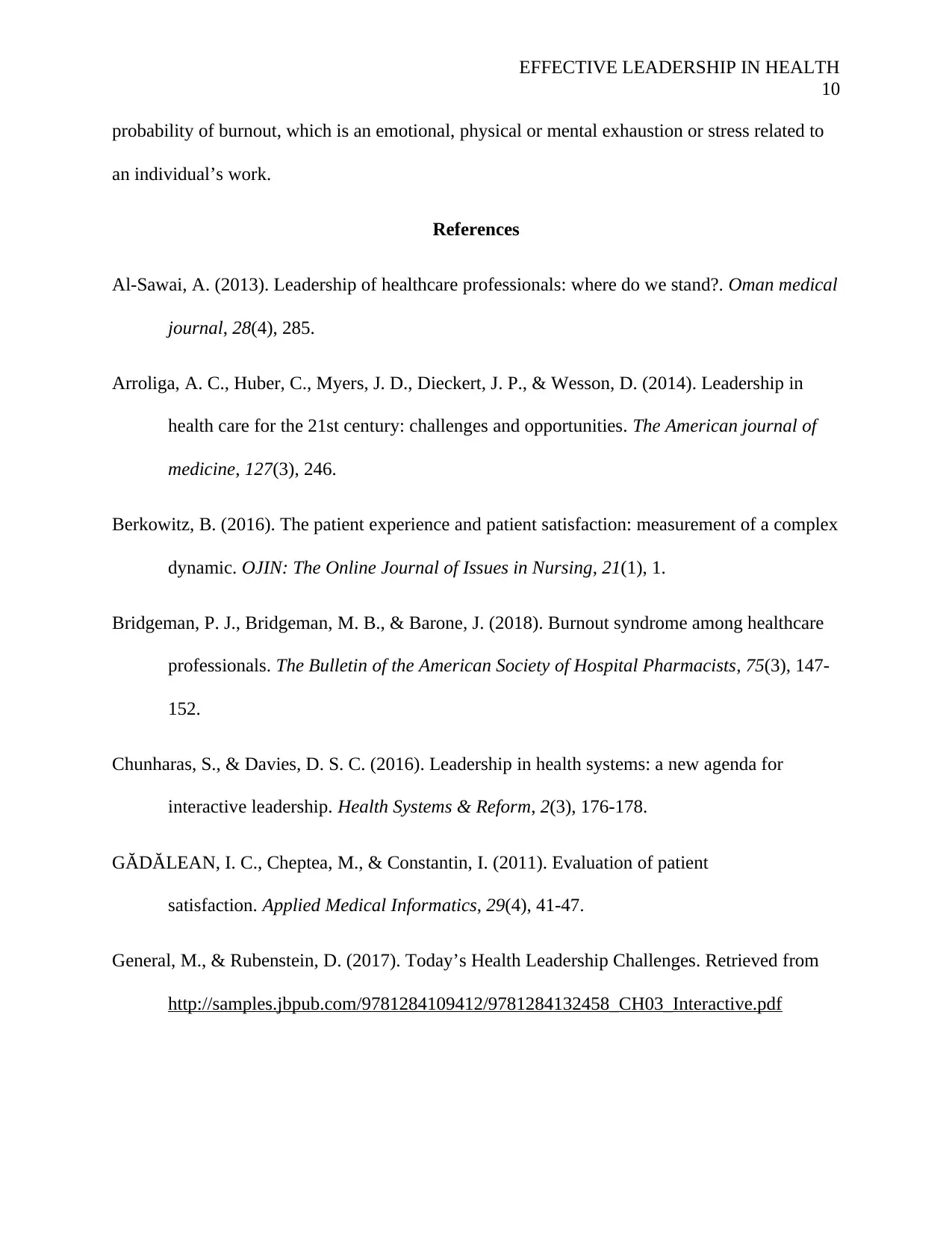
EFFECTIVE LEADERSHIP IN HEALTH
10
probability of burnout, which is an emotional, physical or mental exhaustion or stress related to
an individual’s work.
References
Al-Sawai, A. (2013). Leadership of healthcare professionals: where do we stand?. Oman medical
journal, 28(4), 285.
Arroliga, A. C., Huber, C., Myers, J. D., Dieckert, J. P., & Wesson, D. (2014). Leadership in
health care for the 21st century: challenges and opportunities. The American journal of
medicine, 127(3), 246.
Berkowitz, B. (2016). The patient experience and patient satisfaction: measurement of a complex
dynamic. OJIN: The Online Journal of Issues in Nursing, 21(1), 1.
Bridgeman, P. J., Bridgeman, M. B., & Barone, J. (2018). Burnout syndrome among healthcare
professionals. The Bulletin of the American Society of Hospital Pharmacists, 75(3), 147-
152.
Chunharas, S., & Davies, D. S. C. (2016). Leadership in health systems: a new agenda for
interactive leadership. Health Systems & Reform, 2(3), 176-178.
GĂDĂLEAN, I. C., Cheptea, M., & Constantin, I. (2011). Evaluation of patient
satisfaction. Applied Medical Informatics, 29(4), 41-47.
General, M., & Rubenstein, D. (2017). Today’s Health Leadership Challenges. Retrieved from
http://samples.jbpub.com/9781284109412/9781284132458_CH03_Interactive.pdf
10
probability of burnout, which is an emotional, physical or mental exhaustion or stress related to
an individual’s work.
References
Al-Sawai, A. (2013). Leadership of healthcare professionals: where do we stand?. Oman medical
journal, 28(4), 285.
Arroliga, A. C., Huber, C., Myers, J. D., Dieckert, J. P., & Wesson, D. (2014). Leadership in
health care for the 21st century: challenges and opportunities. The American journal of
medicine, 127(3), 246.
Berkowitz, B. (2016). The patient experience and patient satisfaction: measurement of a complex
dynamic. OJIN: The Online Journal of Issues in Nursing, 21(1), 1.
Bridgeman, P. J., Bridgeman, M. B., & Barone, J. (2018). Burnout syndrome among healthcare
professionals. The Bulletin of the American Society of Hospital Pharmacists, 75(3), 147-
152.
Chunharas, S., & Davies, D. S. C. (2016). Leadership in health systems: a new agenda for
interactive leadership. Health Systems & Reform, 2(3), 176-178.
GĂDĂLEAN, I. C., Cheptea, M., & Constantin, I. (2011). Evaluation of patient
satisfaction. Applied Medical Informatics, 29(4), 41-47.
General, M., & Rubenstein, D. (2017). Today’s Health Leadership Challenges. Retrieved from
http://samples.jbpub.com/9781284109412/9781284132458_CH03_Interactive.pdf
Secure Best Marks with AI Grader
Need help grading? Try our AI Grader for instant feedback on your assignments.
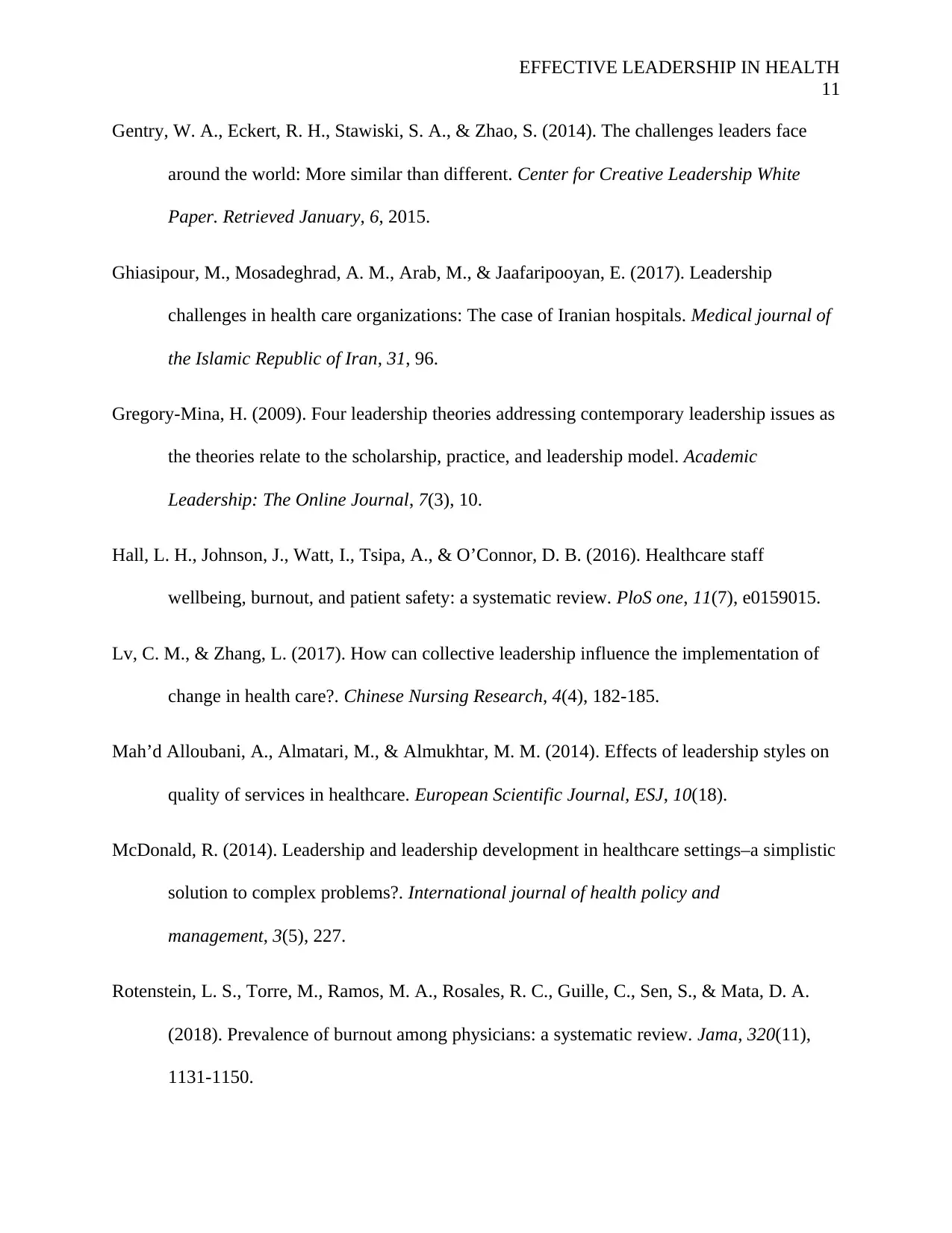
EFFECTIVE LEADERSHIP IN HEALTH
11
Gentry, W. A., Eckert, R. H., Stawiski, S. A., & Zhao, S. (2014). The challenges leaders face
around the world: More similar than different. Center for Creative Leadership White
Paper. Retrieved January, 6, 2015.
Ghiasipour, M., Mosadeghrad, A. M., Arab, M., & Jaafaripooyan, E. (2017). Leadership
challenges in health care organizations: The case of Iranian hospitals. Medical journal of
the Islamic Republic of Iran, 31, 96.
Gregory-Mina, H. (2009). Four leadership theories addressing contemporary leadership issues as
the theories relate to the scholarship, practice, and leadership model. Academic
Leadership: The Online Journal, 7(3), 10.
Hall, L. H., Johnson, J., Watt, I., Tsipa, A., & O’Connor, D. B. (2016). Healthcare staff
wellbeing, burnout, and patient safety: a systematic review. PloS one, 11(7), e0159015.
Lv, C. M., & Zhang, L. (2017). How can collective leadership influence the implementation of
change in health care?. Chinese Nursing Research, 4(4), 182-185.
Mah’d Alloubani, A., Almatari, M., & Almukhtar, M. M. (2014). Effects of leadership styles on
quality of services in healthcare. European Scientific Journal, ESJ, 10(18).
McDonald, R. (2014). Leadership and leadership development in healthcare settings–a simplistic
solution to complex problems?. International journal of health policy and
management, 3(5), 227.
Rotenstein, L. S., Torre, M., Ramos, M. A., Rosales, R. C., Guille, C., Sen, S., & Mata, D. A.
(2018). Prevalence of burnout among physicians: a systematic review. Jama, 320(11),
1131-1150.
11
Gentry, W. A., Eckert, R. H., Stawiski, S. A., & Zhao, S. (2014). The challenges leaders face
around the world: More similar than different. Center for Creative Leadership White
Paper. Retrieved January, 6, 2015.
Ghiasipour, M., Mosadeghrad, A. M., Arab, M., & Jaafaripooyan, E. (2017). Leadership
challenges in health care organizations: The case of Iranian hospitals. Medical journal of
the Islamic Republic of Iran, 31, 96.
Gregory-Mina, H. (2009). Four leadership theories addressing contemporary leadership issues as
the theories relate to the scholarship, practice, and leadership model. Academic
Leadership: The Online Journal, 7(3), 10.
Hall, L. H., Johnson, J., Watt, I., Tsipa, A., & O’Connor, D. B. (2016). Healthcare staff
wellbeing, burnout, and patient safety: a systematic review. PloS one, 11(7), e0159015.
Lv, C. M., & Zhang, L. (2017). How can collective leadership influence the implementation of
change in health care?. Chinese Nursing Research, 4(4), 182-185.
Mah’d Alloubani, A., Almatari, M., & Almukhtar, M. M. (2014). Effects of leadership styles on
quality of services in healthcare. European Scientific Journal, ESJ, 10(18).
McDonald, R. (2014). Leadership and leadership development in healthcare settings–a simplistic
solution to complex problems?. International journal of health policy and
management, 3(5), 227.
Rotenstein, L. S., Torre, M., Ramos, M. A., Rosales, R. C., Guille, C., Sen, S., & Mata, D. A.
(2018). Prevalence of burnout among physicians: a systematic review. Jama, 320(11),
1131-1150.
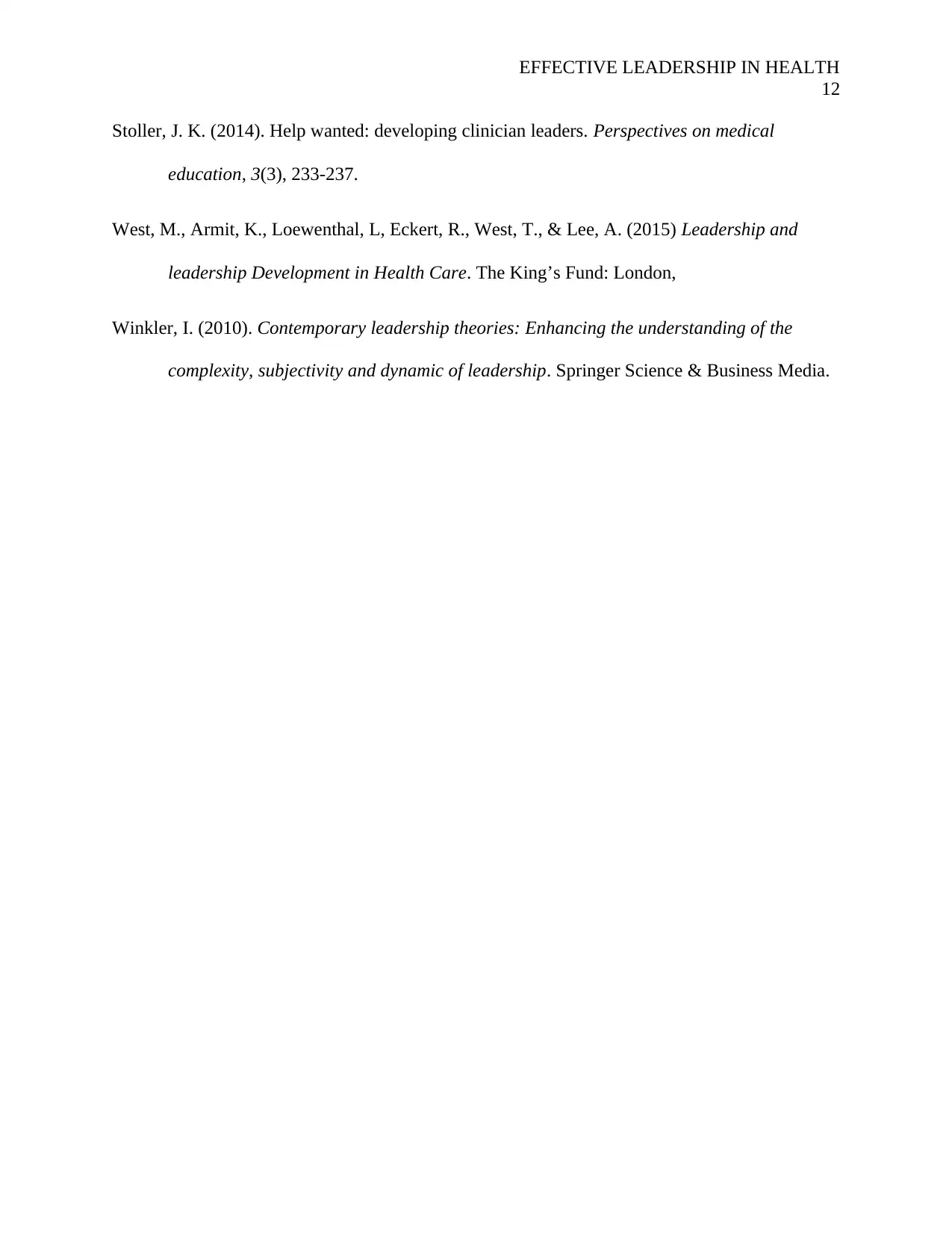
EFFECTIVE LEADERSHIP IN HEALTH
12
Stoller, J. K. (2014). Help wanted: developing clinician leaders. Perspectives on medical
education, 3(3), 233-237.
West, M., Armit, K., Loewenthal, L, Eckert, R., West, T., & Lee, A. (2015) Leadership and
leadership Development in Health Care. The King’s Fund: London,
Winkler, I. (2010). Contemporary leadership theories: Enhancing the understanding of the
complexity, subjectivity and dynamic of leadership. Springer Science & Business Media.
12
Stoller, J. K. (2014). Help wanted: developing clinician leaders. Perspectives on medical
education, 3(3), 233-237.
West, M., Armit, K., Loewenthal, L, Eckert, R., West, T., & Lee, A. (2015) Leadership and
leadership Development in Health Care. The King’s Fund: London,
Winkler, I. (2010). Contemporary leadership theories: Enhancing the understanding of the
complexity, subjectivity and dynamic of leadership. Springer Science & Business Media.
1 out of 12
Related Documents
Your All-in-One AI-Powered Toolkit for Academic Success.
+13062052269
info@desklib.com
Available 24*7 on WhatsApp / Email
![[object Object]](/_next/static/media/star-bottom.7253800d.svg)
Unlock your academic potential
© 2024 | Zucol Services PVT LTD | All rights reserved.





